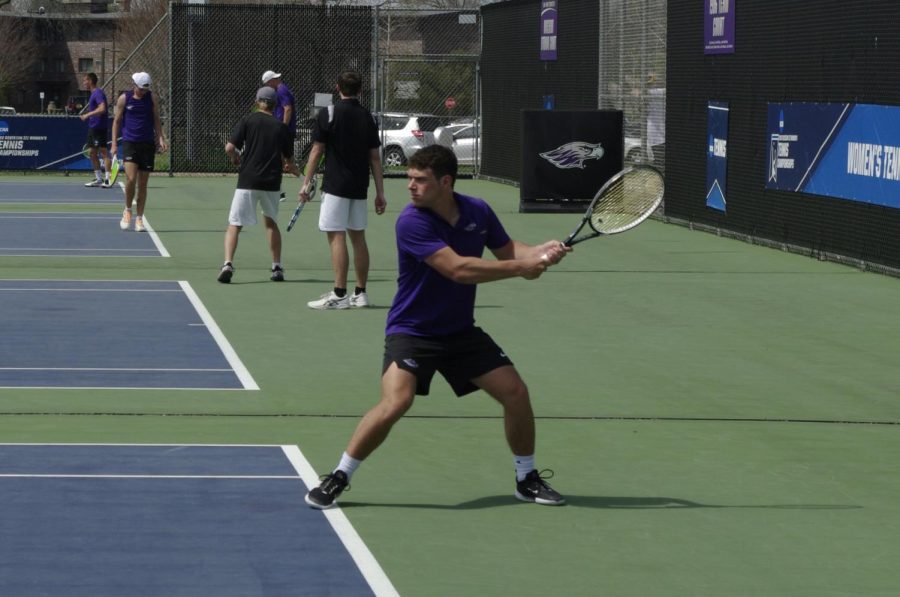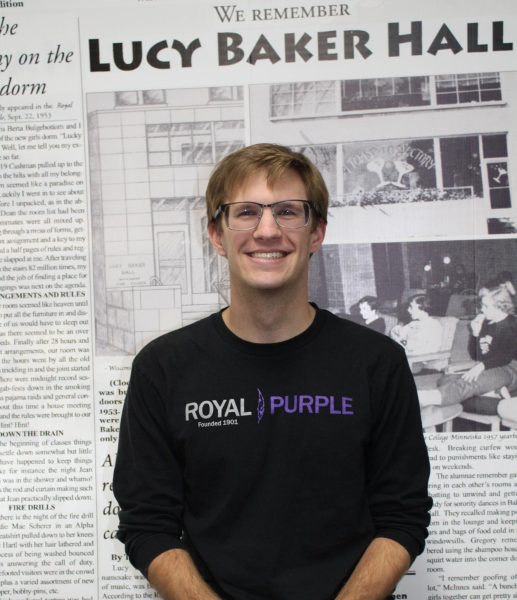Wisconsin teams take on New Jersey
Chase Lindwall goes for a backhand return during his doubles match against Stevens Point on Friday April 14th at Whitewater tennis complex (John Hynst)
April 23, 2023
UW-Whitewater has been one of the top powers in many, if not most, sports in the WIAC for quite some time. But men’s tennis is a power in another conference, the New Jersey Athletic Conference (NJAC). As a matter of fact, there are four Wisconsin teams in the NJAC. How in the world did Wisconsin teams end up in a New Jersey conference?
For head coach Frank Barnes, not being in the WIAC is a regular thing for the men’s team. There haven’t been enough WIAC colleges who sponsor men’s tennis to create a conference for a long time. Due to this, Whitewater and other full-time WIAC teams were independent teams.
“We were always searching for a conference around here for us to hop into but nobody wanted us to hop in because we were pretty strong and we were probably going to steal their AQ from them, so nobody would agree. Then I gave up,” Barnes said.
The lack of a conference began to change in 2019 when the team took a trip out east to play The College of New Jersey (TCNJ) on spring break.
“It was kind of cool because it was a bunch of Wisconsin boys versus a bunch of New Jersey boys, and they were stereotypical Jersey guys, just yelling and screaming and our guys were going nuts. Some coaches would bawk at that but both coaches really liked the environment and thought this could be a good rivalry for the future,” Barnes said.
TCNJ’s program was going through the exact same thing the UWW and its WIAC friends were, four teams and unable to get anyone to join.
“So we said why don’t we just do the champion of ours versus the champion of yours and we’ll call it whatever, WIAC or NJAC,” Barnes said. “We agreed to move to the NJAC. They would be the NJAC East and we would be the NJAC West and the winners would play each other.”
It was a process to join, Barnes said, because athletic directors had to agree and so did the university presidents. Once the logistics were set the COVID-19 pandemic struck and play was restricted. Last year, the third season in the NJAC, was the first time the east and west were able to get together for a championship, which Whitewater won 5-0 over TCNJ.
Needing to fly, or sometimes bus, out east to play the east’s champion can be expensive, but it is worth the cost thanks to all of the benefits being in a conference has. As long as you win the conference, you’re in the national tournament. Now, as Barnes put it, as long as the Warhawks play well at the end of the year against conference opponents they can afford to have a bad loss early in the season, which would have likely prevented them from getting in the tournament during their time as an independent. Plus players are able to get weekly awards from the conference and they have a rivalry to look forward to playing at the end of the year.
Next year, however, the NJAC will be no more. One of the teams out east is leaving the conference, putting the number of full-time NJAC teams in the conference down to three – the needed number of full-time members for a conference is four. Luckily UW-Stevens Point just added men’s tennis putting the WIAC at four full time members and allowing it to sponsor a conference.
Now all the same teams will play in the WIAC next season and the conference will function just as it did as the NJAC. A team plays all the teams in its division, in Whitewater’s case the WIAC East, and if they win the division they will go on to play the other division’s winner to decide the WIAC champion and will earn the automatic bid to the NCAA Tournament. The host of the championship will alternate each year from the East team to the West team.














